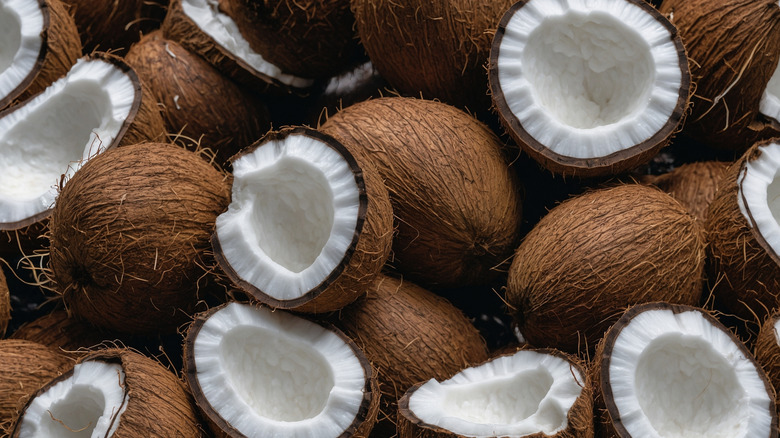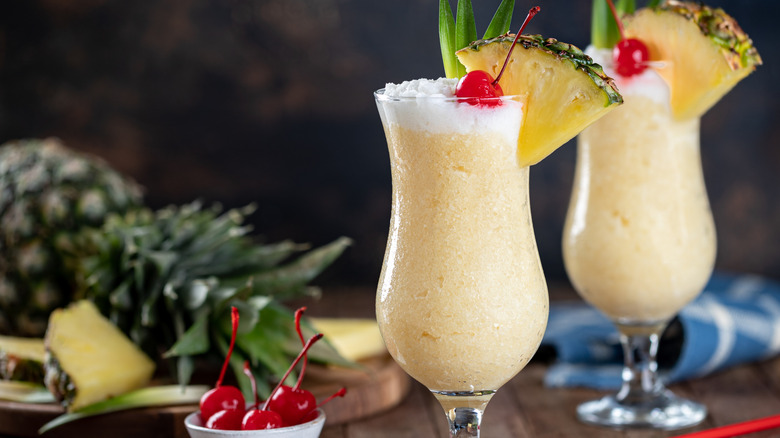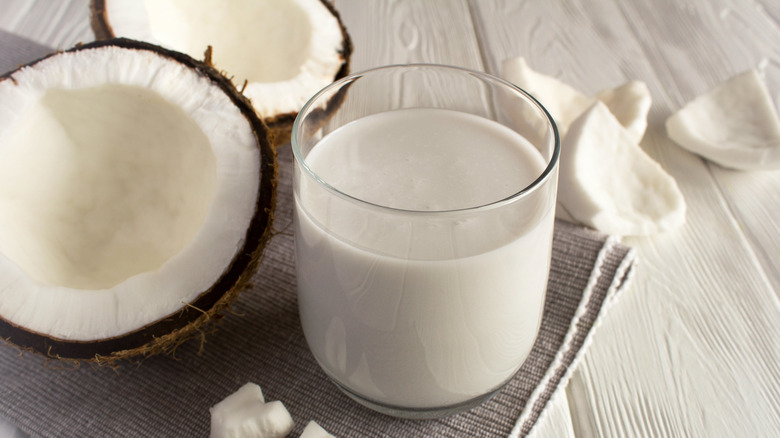Don't Be Fooled. Cream Of Coconut And Coconut Cream Are Not The Same
We may receive a commission on purchases made from links.
Vegan desserts and recipes often call for a can of thick coconut cream to replace a dairy component. In the grocery store, you might spot a can labeled "cream of coconut." Before you reach for that, wait. Although the names are very similar, the order of the wording is important here. Coconut cream and cream of coconut are actually two different products. Both are made from a base of blended coconut flesh, but cream of coconut is heavily sweetened, while coconut cream is not. Piña coladas call for a generous splash of cream of coconut, whereas coconut cream provides the base for Thai curries.
Shopping for these products can be confusing because they are sometimes stocked in the same area, and both are commonly packaged in cans. Luckily, most of the time grocery stores stock cream of coconut with the alcohol mixers or in the baking goods section. If it is not sold in a can, look for a plastic squeeze bottle. Coconut cream is typically stocked with Asian ingredients, international foods, baking staples, or with non-refrigerated dairy-free milks. Aside from a can, it is also sold in a small cardboard box. Pricing varies by brand for each ingredient; a can of coconut cream from the popular Thai Kitchen brand costs $4 to $5, while a can of the favorite Coco Lopez cream of coconut costs around $5.
How to use coconut cream
Coconut cream tends to be a less processed product, as it is just a blend of coconut flesh and coconut water (and sometimes a stabilizer or gum to maintain the consistency). Some brands add a very small amount of sugar, but for the most part, this product is unsweetened. Coconut cream is naturally creamy and thick, and it becomes more solid if the can is stored in the fridge.
Thanks to coconut cream, vegan desserts can be just as creamy and thick as their dairy counterparts. This ingredient makes for a super easy dairy-free whipped cream for topping waffles and crepes, and it can be used in pudding, smoothies, milkshakes, ice cream, cake, tarts, and cheesecakes. Add it to your coffee for the creamiest vegan latte, or blend it into a margarita for a tropical twist.
When it comes to savory applications, coconut cream is perfect for balancing spicy components. It's a key ingredient in Thai curries and as the base of a thick sauce to pair with noodles. For creamy soup recipes or creamed vegetable recipes that call for heavy cream, coconut cream can be used instead. A dairy-free sour cream can be easily made by mixing coconut cream with a little lemon juice.
How to use cream of coconut
The consistency of cream of coconut is one of the most noticeable differences from coconut cream — it's not as thick and very syrupy, similar to condensed milk. It's more processed than coconut cream; it is also derived from coconut meat and water, but sometimes the first ingredient of cream of coconut is coconut concentrate, which has already been cooked down further. Sugar is frequently the second ingredient, and there are typically a variety of preservatives and stabilizers to keep the correct consistency and give the product a longer shelf life.
The number one use for cream of coconut is the piña colada cocktail, Puerto Rico's regional drink. It's what sweetens the drink and gives it a creamy consistency, which is useful for other cocktails as well. Cream of coconut is an ideal addition to fruity, tropical frozen drinks and tiki-style cocktails. Transform a classic martini into a tropical drink with cream of coconut and lime, or blend it into a minty mojito.
There's a place for cream of coconut in dessert recipes too. Rice-based desserts, like vanilla rice pudding or mango sticky rice, are great recipes for sweet cream of coconut to shine. Drizzle it over a dark chocolate brownie or ice cream, glaze a cake, or blend it into milkshakes for a hit of coconut. While savory recipes are not the obvious choice for this ingredient, cream of coconut can be used as a marinade or glaze for tropical seafood dishes.
Can these ingredients be used interchangeably?
In general, recipes that call for coconut cream cannot be replaced by cream of coconut, as it is thinner, syrupy, and much sweeter. There are a few exceptions — if you prefer the sweetness and consistency of cream of coconut, you can use it to replace coconut cream in cocktails and some desserts where texture isn't an important factor.
Overall, coconut cream is the more versatile of the two ingredients, as it is easily used in both sweet and savory applications, and a wide range of drinks. Recipes that call for cream of coconut can generally use coconut cream as a sugar-free swap that will turn out thicker. When using coconut cream to replace the cream of coconut in a recipe where it acts as the sweetener, you can adjust the sweetness level to your liking by adding honey or agave syrup. It's possible to make cream of coconut at home by combining coconut cream with condensed milk or another sweetener.
It's important to note that coconut milk is a different ingredient than coconut cream and cream of coconut. Coconut milk can be canned or packaged in a 1-liter carton as a non-dairy milk. It may be unsweetened or sweetened, and it is thinner because it contains a higher percentage of water. That said, it can also separate, leaving coconut water on the bottom and a layer of cream on top. Coconut milk can be used to replace coconut cream if a slightly thinner consistency is acceptable, but it does not work as a cream of coconut replacement.



